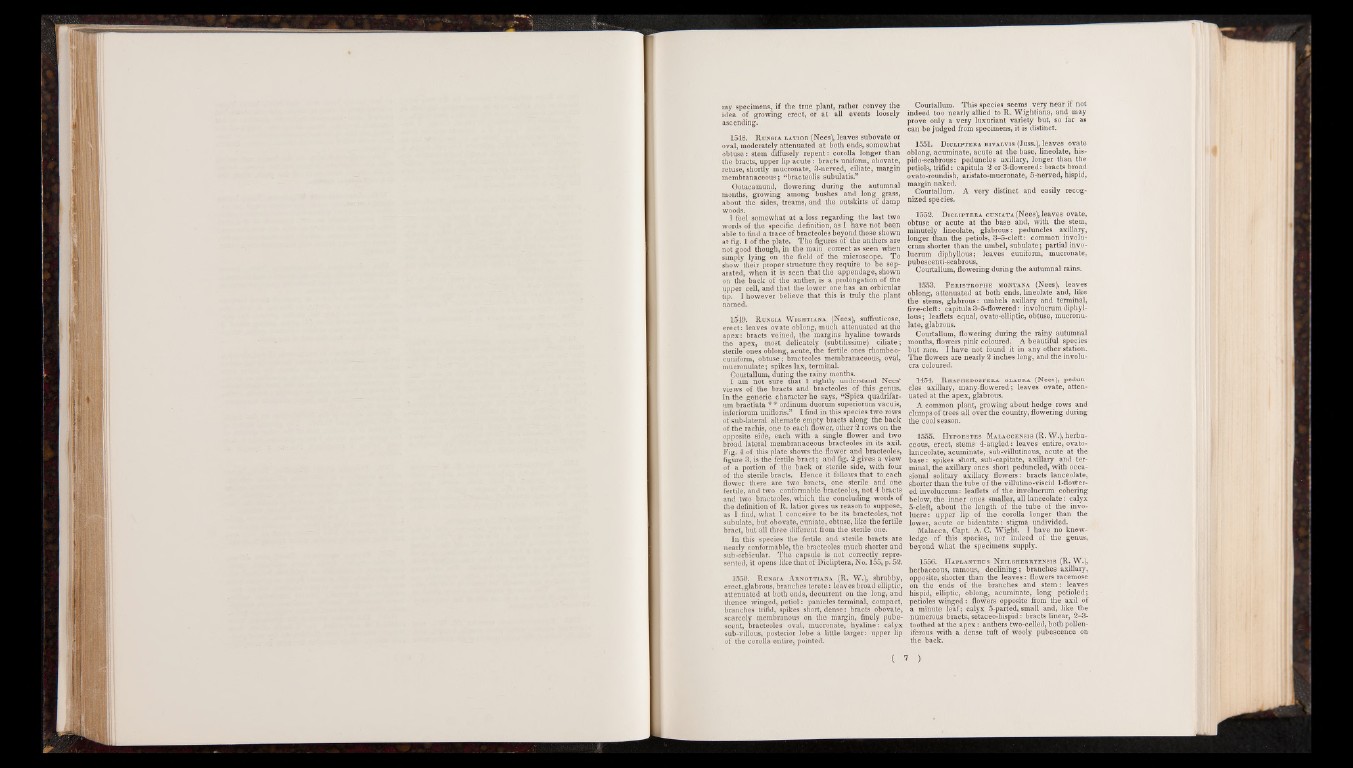
my specimens, if the true plant, rather convey the
idea of growing erect, or at all events loosely
ascending.
1548. Rungia latior (Nees), leaves subovate or
oval, moderately attenuated at both ends, somewhat
obtuse: stem diffusely repent: corolla longer than
the bracts, upper lip acute: bracts uniform, obovate,
retuse, shortly mucronate, 3-nerved, ciliate, margin
membranaceous; “bracteolis subulatis.”
Ootacamund, flowering during the autumnal
months, growing among bushes and long grass,
about the sides, treams, and the outskirts of damp
woods.
I feel somewhat at a loss regarding the last two
words of the specific definition, as I nave not been
able to find a trace of bracteoles beyond those shown
at fig. 1 of the plate. The figures of the anthers are
not good though, in the main correct as seen when
simply lying on the field of the microscope. To
show their proper structure they require to be separated,
when it is seen that the appendage, shown
on the back of the anther, is a prolongation of the
upper cell, and that the lower one has an orbicular
tip. I however believe that this is truly the plant
named.
1549. R ungia Wightiana (Nees), suffruticose,
erect: leaves ovate oblong, much attenuated at the
apex: bracts veined, the margins hyaline towards
the apex, most delicately (subtilissime) ciliate;
sterile ones oblong, acute, the fertile ones rhombeo-
cuniform, obtuse; bracteoles membranaceous, oval,
mucronulate; spikes lax, terminal.
Courtallum, during the rainy months.
I am not sure that I rightly understand Nees’
views of the bracts and bracteoles of this genus.
In the generic character he says, “Spica quadrifar-
um bractiata * * ordinum duorum superiorum vacuis,
inferiorum unifloris.” I find in this species two rows
of sub-lateral alternate empty bracts along the back
of the rachis, one to each flower, other 2 rows on the
opposite side, each with a single flower and two
broad lateral membranaceous bracteoles in its axil.
Fig. 4 of this plate shows the flower and bracteoles,
figure 3, is the fertile bract; and fig. 2 gives a view
of a portion of the back or sterile side, with four
of the sterile bracts. Hence it follows that to each
flower there are two bracts, one sterile and one
fertile, and two conformable bracteoles, not 4 bracts
and two bracteoles, which the concluding words of
the definition of R. latior gives us reason to suppose,
as I find, what I conceive to be its bracteoles, not
subulate, but obovate, cuniate, obtuse, like the fertile
bract, but all three different from the sterile one.
In this species the fertile and sterile bracts are
nearly conformable, the bracteoles much shorter and
sub-orbicular. The capsule is not correctly represented,
it opens like that of Dicliptera, No. 155, p. 52.
1550. Rungia Arnottiana (R. W.), shrubby,
erect, glabrous, branches terete: leaves broad elliptic,
attenuated at both ends, decurrent on the long, and
thence winged, petiol: panicles terminal, compact,
branches trifid, spikes snort, dense: bracts obovate,
scarcely membranous on the margin, finely pubescent,
bracteoles oval, mucronate, hyaline: calyx
sub-villous, posterior lobe a little larger: upper lip
of the corolla entire, pointed.
Courtallum. This species seems very near if not
indeed too nearly allied to R. Wightiana, and may
prove only a very luxuriant variety but, so far as
can be judged from specimens, it is distinct.
1551. Dicliptera bivalvis (Juss.), leaves ovate
oblong, acuminate, acute at the base, lineolate, his-
pido-scabrous: peduncles axillary, longer than the
petiols, trifid: capitula 2 or 3-flowered: bracts broad
ovato-roundish, aristato-mucronate, 5-nerved, hispid,
margin naked.
Courtallum. A very distinct and easily recognized
species.
1552. Dicliptera cuniata (Nees), leaves ovate,
obtuse or acute at the base and, with the stem,
minutely lineolate, glabrous: peduncles axillary,
longer than the petiols, 3-5-cleft: common involu-
crum shorter than the umbel, subulate; partial invo-
lucrum diphyllous; leaves cuniform, mucronate,
pubescenti-scabrous,
Courtallum, flowering during the autumnal rains.
1553. Peristrophe Montana (Nees), leaves
oblong, attenuated at both ends, lineolate and, like
the stems, glabrous: umbels axillary and terminal,
five-cleft: capitula 3-5-flowered: involucrumdiphyllous
; leaflets equal, ovato-elliptic, obtuse, mucronulate,
glabrous.
Courtallum, flowering during the rainy autumnal
months, flowers pink coloured. A beautiful species
but rare. I have not found it in any other station.
The flowers are nearly 2 inches long, and the involu-
cra coloured.
1454. Rhaphedospera glabra (Nees), peduncles
axillary, many-flowered; leaves ovate, attenuated
at the apex, glabrous.
A common plant, growing about hedge rows and
clumps of trees all over the country, flowering during
the cool season.
1555. Hyfoestes Malaccensis (R. W.), herbaceous,
erect, stems 4-angled: leaves entire, ovato-
lanceolate, acuminate, sub-villutinous, acute at the
base: spikes short, sub-capitate, axillary and terminal,
the axillary ones short peduncled, with occasional
solitary axillary flowers: bracts lanceolate,
shorter than the tube of the villutino-viscid 1-floWer-
ed involucrum: leaflets of the involucrum cohering
below, the inner ones smaller, all lanceolate: calyx
5-cleft, about the length of the tube of the involucre
: upper lip of the corolla longer than the
lower, acute or bidentate: stigma undivided.
Malacca, Capt. A. C. Wight. I have no knowledge
of this species, nor indeed ,of the genus,
beyond what the specimens supply.
1556. Haplanthus Neilgherryensis (R. W.),
herbaceous, ramous, declining; branches axillary,
opposite, shorter than the leaves: flowers racemose
on the ends of the branches and stem : leaves
hispid, elliptic, oblong, acuminate, long petioled;
petioles winged: flowers opposite from the axil of
a minute lea f; calyx 5-parted, small and, like the
numerous bracts, setaceo-hispid: bracts linear, 2-3-
toothed at the apex: anthers two-celled, both pollen-
iferous with a dense tuft of wooly pubescence on
the back.